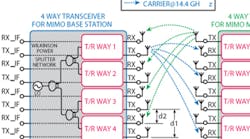CMOS Transceiver Tackles 210 GHz with OOK Modulation
Affordable radio communications devices for millimeter-wave frequencies will free the way for low-cost communications across short distances in relatively unused frequency bands. To take advantage of some of these higher frequencies, Zheng Wang, Pei-Yuan Chiang, Peyman Nazari, Chun-Cheng Wang, Zhiming Chen, and Payam Heydari of the Nanoscale Communication IC (NCIC) Labs at the University of California, Irvine developed a fundamental-frequency radio transceiver for use at 210 GHz. The transceiver is based on a 32-nm SOI silicon CMOS semiconductor process; it employs on-off-keying (OOK) modulation in support of data rates to 10 Gb/s.
This 210-GHz transceiver includes an OOK modulator, a power amplifier driver, a differential power distribution network, four power amplifiers, a voltage-controlled oscillator (VCO), and a 2 × 2 dipole antenna array on the transmit side. The receive side features a receiver with an on-chip antenna, a low-noise amplifier, and a power detector. The LNA exhibits in-band gain of 18 dB and minimum noise figure of 11 dB. The transmitter achieves EIRP of +5.13 dBm at 10-dB backoff from the saturated output-power level. The different components on the transceiver, such as the LNA, have been characterized with the aid of a commercial microwave vector network analyzer (VNA), with a highest measurable frequency of 220 GHz. The transceiver chip includes a transmit section of 1.4 × 2.5 mm2 while the receiver section occupies an area of 0.8 × 1.4 mm2. Because of the on-chip antenna integration, a low-cost assembly was achieved without any need of millimeter-wave bonding techniques.
The transceiver was tested under practical conditions, where a modulated continuous-wave (CW) modulated signal from the transmitter was sent to the receiver across a distance of 3.5 cm. The signal is produced by modulating a baseband signal sent to the transmitter to a frequency of 210 GHz. The receiver captures the signal and detects the baseband signal. The receiver has a full bandwidth of 20 GHz and is found to achieve receive sensitivity of -47 dBm with receive noise figure of about 12 dB. The transceiver can achieve short-range data rates to 10 Gb/s without filtering and to 20 Gb/s with ideal filtering. See “A CMOS 210-GHz Fundamental Transceiver With OOK Modulation,” IEEE Journal of Solid State Circuits, March 2014, p. 564.
